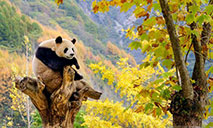Guardians of the Tibetan antelope
XINING, Nov. 4 (Xinhua) -- Hoh Xil, in the hinterland of the Qinghai-Tibet Plateau, seems to be more vast and desolate in late autumn. Like every silky morning in the mist, patroller Sidegya got up early, wearing a hat and gloves, and headed to "the kindergarten of baby Tibetan antelopes" at an altitude of more than 4,400 meters.
Every May, pregnant Tibetan antelopes start to migrate to Hoh Xil to give birth, returning to their habitats with their calves around August. During the migration journey, some calves fall behind and get separated from the herd. Those left behind are sent to the wildlife rescue center at the Sonam Dargye Protection Station, winning it the name of "the kindergarten of baby Tibetan antelopes," and the patrollers there are thought of as the guardians of the animal.
"When I was patrolling the mountains around Zonag Lake at the Hoh Xil National Nature Reserve last year, I found several lost antelopes and brought them back to the station," Sidegya said. "It's become a routine now to check on them every morning."
The patroller unlocked the fence deftly and approached seven Tibetan antelopes for a closer look. "Considering the drastic temperature difference between day and night since October, we built a special 'room' covered with grass and quilts and surrounded by windshields, where the animals can escape the cold."
The 27-year-old guardian of the plateau elf has been serving for six years in Hol Xil where the Tibetan antelopes thrive amid the country's active anti-poaching and biodiversity protection efforts.
Poaching sprees had once driven the species to the edge of extinction, and the population dropped from 200,000 to 20,000 during the 1980s when they were hunted for expensive shawls. Each shawl, priced as high as 50,000 U.S. dollars, was made at the expense of three to five antelopes.
To curb the rampant slaughter of Tibetan antelopes and save them from extinction, Qinghai set up the Hoh Xil provincial-level nature reserve in 1996, and it was upgraded to a state-listed reserve in 1997.
Since 1992, more than 100 patrollers have taken roots in Hoh Xil. "Now, a total of 63 patrollers are fighting on the frontlines of ecological protection in the region, of whom young people born in the 1980s and 1990s account for 90 percent," said Buchou, director of Hoh Xil management office under the management bureau of Sanjiangyuan National Park.
Thanks to the anti-poaching campaign and the ban on illegal hunting, Hoh Xil is now home to more than 70,000 Tibetan antelopes. According to the reserve, not a single gunshot has been heard in the reserve since 2009, and it is now free from poachers.
In August, the status of Tibetan antelopes in China has been downgraded from "endangered" to "near threatened," said the National Forestry and Grassland Administration.
"Although the population of the animal has recovered steadily, more than 10 large-scale mountain patrols take place annually," Buchou said.
Extreme living conditions are by no means easy to adapt to. The place where the patrollers work is at an average elevation of over 4,600 meters, with oxygen levels likely to be 55 percent lower than other plain areas.
The uninhabited land lives up to its name.
In July, Sidegya found two Tibetan antelope calves in need of help -- one was stuck in a crack, and the other was trapped by water and was too scared to move.
On the way back to the protection station after rescuing the animals, Sidegya's motorcycle broke down and things got even worse when sudden rain poured down.
"To prevent the calves from getting wet, I wrapped them in clothes and held them in my arms, walking dozens of kilometers. It was totally dark when we returned to the station," he said. "It's never an easy job but whenever I see the animal running happily, I feel it's all worth it."
Photos
Related Stories
Copyright © 2021 People's Daily Online. All Rights Reserved.










